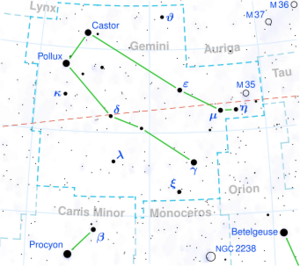Astronomy:U Orionis
| Observation data Equinox J2000.0]] (ICRS) | |
|---|---|
| Constellation | Orion |
| Right ascension | 05h 55m 49.17076s[1] |
| Declination | +20° 10′ 30.6779″[1] |
| Apparent magnitude (V) | 4.8 - 13.0[2] |
| Characteristics | |
| Spectral type | M6e-M9.5e[2] |
| B−V color index | +2.07[3] |
| Variable type | Mira[2] |
| Astrometry | |
| Parallax (π) | 3.4924 ± 0.1820[1] mas |
| Distance | 930 ± 50 ly (290 ± 10 pc) |
| Details | |
| Mass | 0.88[4] M☉ |
| Radius | 370±96[5] R☉ |
| Luminosity | 7,000[6] L☉ |
| Surface gravity (log g) | −0.44[4] cgs |
| Metallicity [Fe/H] | 0.54[4] dex |
| Other designations | |
| Database references | |
| SIMBAD | data |
U Orionis (abbreviated U Ori) is a Mira-type variable star in the constellation Orion. It is a classical long period variable star that has been well observed for over 120 years.
Discovery
It was discovered on 1885 December 13 by J.E. Gore and initially it was thought to be a nova in the early stages of decline (Gore's Nova and NOVA Ori 1885 as still listed in SIMBAD), but a spectrum taken at Harvard showed features similar to that of Mira. Thus U Orionis became the first long period variable to be identified by a photograph of its spectrum.[8]
Location
U Orionis lies less than half a degree east of the small-amplitude variable star χ1 Orionis and less than an arc-minute from the much fainter eclipsing variable UW Orionis. χ1 Orionis is slightly brighter than U Orionis at its brightest maximum, while UW Orionis is more than a thousand times fainter, similar to U Orionis at minimum.
Stellar parameters

The star has a low effective temperature (variable with the pulsations, but roughly 2,700 K), a large and bloated radius of 370 R☉,[5] and a high luminosity, 7,000 times higher than the Sun.[6] If the Sun were replaced with U Orionis, its radius would extend beyond Mars's orbital zone (about 1.7 astronomical units).
Possible planetary system
According to Rudnitskij,[10] a 12- to 15-year "super-periodicity" has been observed. The author infers such periodicity could coincide with the revolution period of an invisible companion, probably planetary. So far no clear hint of planetary objects has been detected.
References
- ↑ 1.0 1.1 1.2 Brown, A. G. A. (2021). "Gaia Early Data Release 3: Summary of the contents and survey properties". Astronomy & Astrophysics 649: A1. doi:10.1051/0004-6361/202039657. Bibcode: 2021A&A...649A...1G. Gaia EDR3 record for this source at VizieR.
- ↑ 2.0 2.1 2.2 Samus', N. N.; Kazarovets, E. V.; Durlevich, O. V.; Kireeva, N. N.; Pastukhova, E. N. (2017). "General catalogue of variable stars: Version GCVS 5.1". Astronomy Reports 61 (1): 80. doi:10.1134/S1063772917010085. Bibcode: 2017ARep...61...80S.
- ↑ Mermilliod, J.-C. (1986). "Compilation of Eggen's UBV data, transformed to UBV (unpublished)". Catalogue of Eggen's UBV Data. Bibcode: 1986EgUBV........0M.
- ↑ 4.0 4.1 4.2 Cite error: Invalid
<ref>tag; no text was provided for refs namedstarhorse - ↑ 5.0 5.1 Van Belle (1996). "Angular Size Measurements of 18 Mira Variable Stars at 2.2 microns". Astronomical Journal 112: 2147. doi:10.1086/118170. Bibcode: 1996AJ....112.2147V.
- ↑ 6.0 6.1 Mondal; Chandrasekhar (2004). "Evidence of asymmetry in Mira variable U Ori". Monthly Notices of the Royal Astronomical Society 348 (4): 1332–1336. doi:10.1111/j.1365-2966.2004.07454.x. Bibcode: 2004MNRAS.348.1332M.
- ↑ "V* U Ori". SIMBAD. Centre de données astronomiques de Strasbourg. http://simbad.u-strasbg.fr/simbad/sim-basic?Ident=V%2A+U+Ori.
- ↑ Monck (1887). "Mr Gore's Nova Orionis". The Observatory 10: 69–71. Bibcode: 1887Obs....10...69M.
- ↑ "Download Data". AAVSO. https://www.aavso.org/data-download.
- ↑ Rudnitskij (2002). "Molecular Masers in Variable Stars". Publications of the Astronomical Society of Australia 19 (4): 499–504. doi:10.1071/AS02018. Bibcode: 2002PASA...19..499R.
 |



